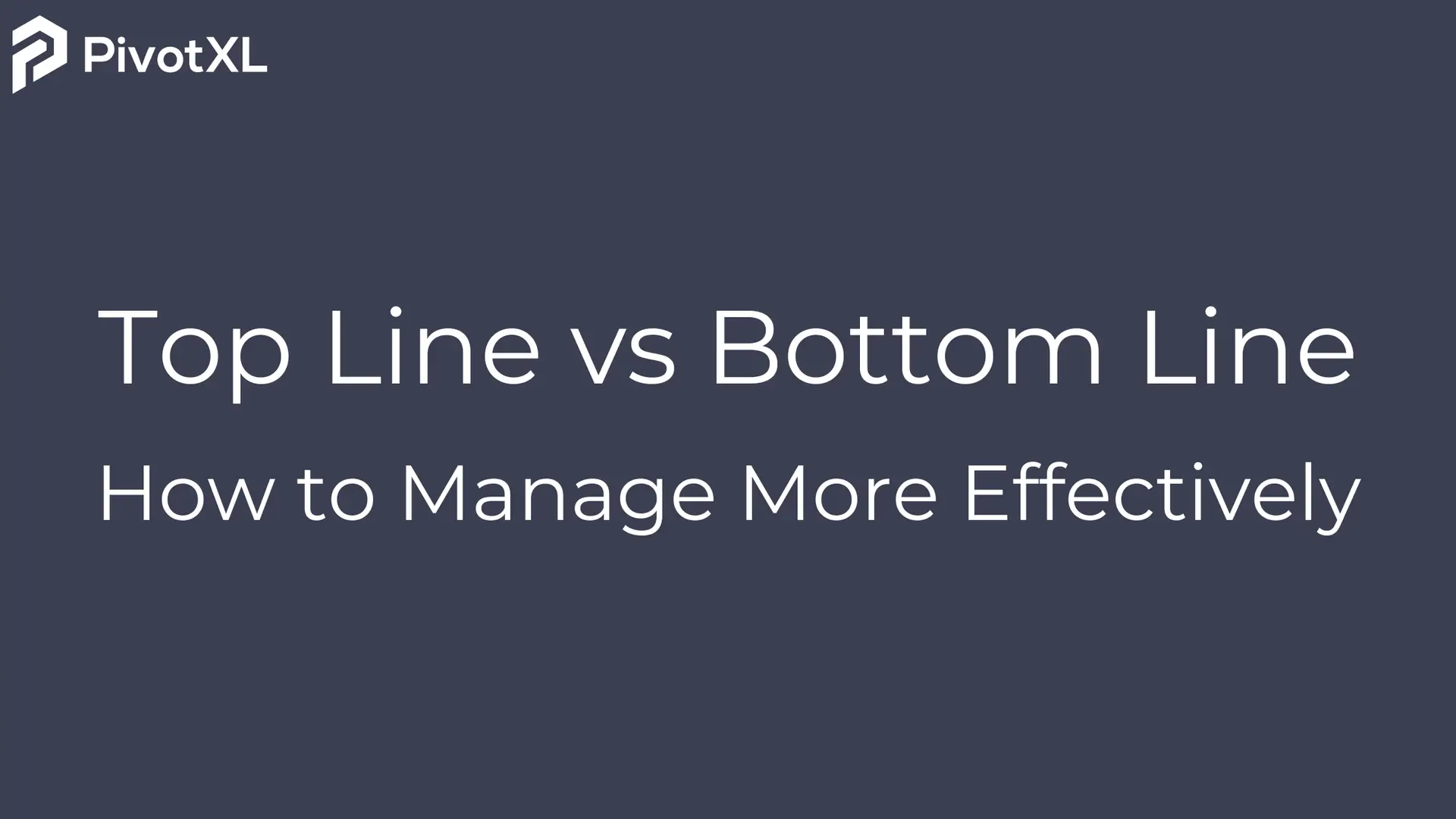In the world of business, two key metrics often used to assess a company’s financial health are its top line vs bottom line. Both are pivotal to understanding how well a business is performing, but each reflects a different aspect of the company’s financial condition. In particular, for SaaS companies, which operate under a unique subscription-based model, the top line vs bottom line offer invaluable insights into business success, profitability, and operational efficiency. This guide will walk you through both metrics in detail and show how SaaS companies can balance top line vs bottom line growth for sustainable success. We will also explore how tools like PivotXL can help streamline the tracking of these key performance indicators.
Understanding the Concept of Top Line
The term “top line” refers to a company’s gross revenue, often found at the top of the income statement. It includes the total amount of income generated from a company’s core business operations before any costs or expenses are deducted. For SaaS companies, top-line revenue predominantly comes from subscription sales, though additional sources like licensing fees, training services, support contracts, and customizations may also contribute, though to a lesser degree.
Top-line growth is a key performance indicator for external stakeholders, such as investors, journalists, and board members. A growing top line signals that a company is successfully attracting new customers, retaining existing ones, and scaling its revenue-generating capabilities. For SaaS businesses, a positive top-line trajectory often suggests that the company has achieved a good product-market fit, indicating that the product meets market needs and is well-received by its target audience.
The top line is also a critical indicator for early- and growth-stage SaaS companies. A rapidly expanding top line can attract potential investors who see the company’s growth as a sign of strong business potential and future returns on investment.
Useful Metrics for Evaluating Top-Line Growth
To evaluate top-line growth effectively, SaaS businesses rely on several key performance indicators (KPIs). These KPIs provide insight into how well a company is managing customer acquisition and retention, its revenue sources, and its market positioning.
1. Annual Recurring Revenue (ARR)
One of the most reliable metrics for SaaS businesses is Annual Recurring Revenue (ARR). ARR represents the predictable, recurring revenue that a company earns annually from its subscription-based business model. This metric includes revenue from new customers, upgrades, downgrades, and cancellations. It is widely used because it provides a comprehensive picture of long-term business stability and growth potential.
ARR allows companies to forecast future revenue more accurately, making it an essential tool for financial planning and investor confidence. The more predictable and stable a company’s ARR, the more attractive it becomes to potential investors, as it signifies reliable, recurring income.
2. Monthly Recurring Revenue (MRR)
While ARR offers a long-term view of recurring revenue, Monthly Recurring Revenue (MRR) provides a snapshot of revenue on a monthly basis. MRR is helpful for tracking short-term revenue trends and gauging the immediate financial health of the business.
Tracking MRR helps SaaS businesses stay agile and responsive to market conditions, as they can quickly identify patterns or dips in revenue. For example, a sudden drop in MRR could signal customer churn or a need to adjust pricing strategies.
3. Number of Customers
In SaaS businesses, the number of customers is a key driver of revenue. Unlike traditional businesses where each sale generates one-time income, SaaS companies earn recurring revenue from every customer on an ongoing basis. This makes it crucial for SaaS companies to monitor their customer acquisition rates, customer lifetime value (CLV), and churn.
The more customers a SaaS company has, the higher its top-line revenue will be. As such, increasing the customer base is often the primary focus for SaaS businesses looking to drive top-line growth.
4. Customer Retention and Churn Rate
Both customer retention and churn rate offer insight into the sustainability of a company’s revenue stream.
- Customer Retention Rate measures the percentage of customers who continue subscribing to a service over a given period. High retention rates indicate customer satisfaction, strong product-market fit, and value perception.
- Churn Rate is the inverse—measuring the percentage of customers who cancel their subscriptions within a set period. High churn rates suggest that customers are not satisfied with the product or the service provided.
For SaaS businesses, minimizing churn and improving retention are key to driving long-term top-line growth. Customer loyalty not only keeps revenue steady but also reduces the cost of customer acquisition over time.
Understanding the Concept of Bottom Line
The bottom line, in contrast to the top line, refers to the net income or profit that a company retains after all operating expenses have been deducted from the gross revenue. This metric is found at the bottom of the income statement, hence the term “bottom line.”
The bottom line reflects how efficiently a company converts its revenue into profit. For SaaS businesses, several factors can influence the bottom line, such as operational costs, research and development (R&D), sales and marketing (S&M) expenses, and general and administrative (G&A) costs.
While top-line growth is important for showing the company’s ability to generate revenue, the bottom line is an essential measure of profitability and cost management. A positive bottom line indicates that the company is not just generating revenue, but also effectively controlling its costs to maintain healthy profit margins.
Key Metrics for Evaluating Bottom-Line Growth
Several metrics help SaaS companies evaluate their bottom-line performance, providing insights into profitability and cost management.
1. Net Income:
Net income is the most direct measure of profitability. It represents the amount of money a company retains after subtracting all operating expenses from its total revenue. For SaaS businesses, achieving a positive net income is crucial for long-term sustainability and growth.
Early-stage SaaS companies may operate at a loss due to high R&D and customer acquisition costs. However, the goal should always be to reach positive net income as the business matures and scales.
2. Profit Margin:
The profit margin, or net income-to-revenue ratio, indicates how much profit a company is generating from each dollar of revenue. A higher profit margin indicates effective cost management and operational efficiency, while a low profit margin suggests that a company is not converting enough of its revenue into profit.
For SaaS businesses, a high profit margin is particularly important as it demonstrates the efficiency of their subscription-based revenue model in covering operational costs.
How Top-Line Growth Affects Bottom-Line Growth
Top-line and bottom-line growth are not isolated from one another—they are deeply interconnected. The top line can have a direct influence on the bottom line, but the relationship is more complex than simply one driving the other.
Direct Influence of Top-Line Growth on Bottom-Line Profitability
When top-line revenue grows, it can lead to an increase in profitability. However, this growth can only translate into a positive bottom line if the company can control its costs effectively. In many SaaS companies, as revenue increases, so too do costs—particularly in areas such as customer acquisition, support services, and cloud infrastructure.
Therefore, top-line growth must be accompanied by cost management strategies that ensure expenses don’t rise disproportionately to revenue.
Scale and Efficiency
For SaaS businesses, the cost of goods sold (COGS) typically remains relatively constant as revenue grows. As the company scales, it can benefit from economies of scale, which means that per-unit costs decrease as the company grows.
With greater scale, SaaS companies can maintain their sales and marketing expenses at stable levels, making each dollar spent more effective and improving their profitability. This scale advantage can drive a higher profit margin and a stronger bottom line.
Reinvesting in Growth
While focusing on top-line growth, SaaS businesses often reinvest a portion of their revenue into product development, expanding into new markets, and enhancing customer experience. These investments are crucial for ensuring the business remains competitive and innovative.
While reinvesting profits may temporarily reduce the bottom line, the long-term goal is to fuel further growth, which ultimately leads to higher profitability.
Investor Perception and Market Growth
Strong top-line growth attracts investors who are looking for businesses with the potential for substantial returns. When investors provide capital, businesses can further invest in growth initiatives, creating a positive feedback loop that benefits both the top line vs bottom line.
Balancing Top-Line and Bottom-Line Growth
Striking the right balance between top-line and bottom-line growth is one of the most challenging aspects of financial management, especially for SaaS companies in their early and growth stages. Overemphasizing one metric at the expense of the other can result in poor financial health.
Strategic Cost Management
To balance growth with profitability, SaaS businesses must manage their costs strategically. This involves creating realistic budgets, closely monitoring expenditures, and focusing on high-return initiatives that contribute to both top-line growth and bottom-line profitability.
Revenue Quality vs. Quantity
Not all revenue is created equal. Some customers or product lines may generate high-margin revenue, while others may require significant investment in support or customization. Prioritizing high-margin revenue streams is key to maximizing profitability.
Investment in Innovation
SaaS businesses must constantly innovate to stay ahead of competitors. Innovation, however, requires investment—both in terms of time and resources. Balancing short-term profitability with long-term R&D investments is essential for sustaining growth and improving the top line vs bottom line.
How PivotXL Can Help Track and Manage Both Top Line and Bottom Line
Achieving a balance between top line vs bottom line growth requires accurate, real-time data on both metrics. PivotXL provides a comprehensive financial management platform that helps businesses track their top-line and bottom-line performance simultaneously.
PivotXL integrates data from multiple systems and sources, automating the calculation of key financial metrics such as ARR, MRR, net income, and profit margin. This eliminates the need for manual data consolidation, saving time and reducing the risk of errors. By offering real-time visibility into both revenue and expenses, PivotXL empowers SaaS businesses to make data-driven decisions that optimize growth and profitability.




